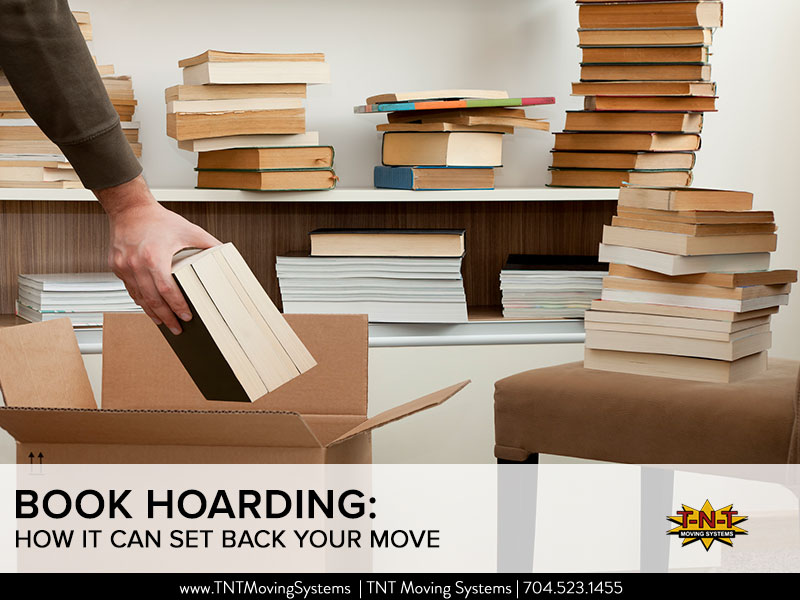The Weightiness of Hoarding Books
Books hold a wealth of knowledge and entertainment for those who are willing to read them, but all of that enjoyment can get heavy when it is time to move. With e-readers and digital ways to obtain information, why are people still holding on so tightly to their books? Perhaps it is the nostalgia or because they just prefer holding an actual book and reading off of a real page, but booklovers everywhere should beware: moving books is often not friendly to the owner, or the book.
You might not realize it, but book hoarding is actually very common and has even been recognized as a medical condition. If you were to ask a medical practitioner, he would tell you that a person who obsessively hoards books has a condition known as “bibliomania.” Though many of us are not actually considered bibliomaniacs, we might still have some pretty hefty libraries of our own.
Here are some tips to help keep your library (somewhat) manageable:
- Only allow yourself to display a set number of books at a given time. Actually choose a set number to display so that your books do not become stacks of clutter.
- Organize your collection by category, author’s last name, genre, or alphabetically, whether they are being displayed or put in storage. By categorizing your books, you can find them easier when you know what you are looking for.
- Store your books upright. Doing this will help preserve and protect the spine and cover of your beloved books.
- If you have to store your books horizontally, try not to stack more than four together. Stacking more than four on top of each other can cause them to concave from pressure and can lead to damage of the spine, pages, and/or cover of the book.
- Out with the old and in with the new. If you add a new book to your collection, take out an old one. This will help you decrease the clutter that comes with your personal library and can make a young collectors day!
Many people try to declutter when moving to a new house or apartment, but one trend that has remained is people packing away too many books, even ones that they do not read anymore! As the amount of books they have increases, so does the weight of boxes they have to move. On average, the standard paperback novel weighs about 15.6 ounces; hard cover books weigh even more. At that rate, having ten paperback novels weighs almost ten pounds! Just imagine how much weight in books a book hoarder has to move.
Aside from how heavy they can get, actually moving the books can have some repercussions. Common issues when transporting books include ripped or bent pages, bent spines, and water damage. Books with leather binding can also dehydrate if they are in the wrong climate for too long.
With so many possible issues, how can a book lover move easily while still keeping all of his or her beloved books? Here are some tips to help you transport your personal library safety.
- Look for strong, sturdy cardboard boxes, but make sure that they are not too big. Keeping the box semi small will make it easier to carry when it is full with books.
- Line each box with tissue or packing paper before filling them, especially if you are packing hardcover books that have slipcovers on them. This will keep the covers from getting ruined and will protect the book’s spine and cover more thoroughly.
- Put the largest books in the bottom of the box first.
- Pack books flat. If you stand your books up when you pack them, the book is more likely to be damaged. Depending on the size and shape of the book, you should be able to fit about two separate stacks of books in each box.
- Do not overfill the boxes. It is actually helpful to leave about an inch between the stack of books and the top of the box, especially if you are using tissue or packing paper to protect the books.
- Fill the gaps in the box to help secure the books and hold them in place. This is another way to use tissue or packing paper! If books are not secure, then they will slide around the box and could be damaged or even damage another book.
- Be generous with the amount of packing tape you use. After all, the last thing you want is for the box to break open because it cannot support the weight of the books inside.
- Do not forget to label the boxes. This is helpful to movers so they know that the box will be heavy and that it should be put on the bottom of the stack of other boxes.
While following these steps will help ensure the safety of your books during a move, it can also be expensive. Try to prepare for your move early by saving boxes and newspapers to wrap and pack your books.
While some movers suggest that you handle packing your precious books by yourself, at TNT Moving Systems, we want to move you! We have been helping residential and commercial customers move to a new residence for more than two decades and have moved everything from couches to fine china.
At TNT Moving Systems, we understand that your items are valuable to you, especially your book collection, and we want to do everything we can do keep them safe between point A and point B. With the practice and expertise we have acquired, we will treat your beloved books with just as much tenderness as you would – maybe even a little better! We are fully licensed, insured, and bonded and train all of our movers to pack and handle your items with the upmost care and respect while they are wrapping, packing, and loading your belongings.
Our teams understand that moving day can turn into a last-minute scramble to get everything on the moving truck, and we want to eliminate that stress. With some preparation on your part, our moving team can work to make sure everything is neatly packing into a box, clearly labeled, and on the moving truck when you are ready to go. Let us focus on the big items so you can make sure you have all of the essentials ready.
We understand that some individuals are afraid of letting someone else handle their belongings. Even if that’s how you feel, we still want to help make your move as easy as possible. Here are some tips to make your packing experience easier:
- First things first, you are going to need to gather packing supplies. The essentials are boxes, padding, blankets, and tape.
Even though most moving companies sell boxes, you can often find them for free. Visit your local grocery or retail stores and ask if they have any left over from their shipments. Check to see if you have the original boxes for your electronics stashed anywhere, too! Padding, such as bubble wrap, is helpful for cushioning fragile items in boxes. Don’t want to buy bubble wrap? Try using towels or shirts that have not been packed yet. Blankets are useful for covering large furniture items so they do not get damaged, especially tables. Using blankets that you have lying around the house is the easiest way; after all, you were going to pack them anyway! Tape is essential for any move. It helps keep all of the boxes closed and sealed while they are being carried from place to place. At the end of the day, there is absolutely no substitute for duct tape. - Once you have all of your supplies, you can finally start packing. It can be helpful to start by sorting things into categories and getting rid of anything that you do not want or need. There is no sense to drag around things that you were planning on getting rid of anyway. You can donate or sell anything that you choose not to keep.
- Pack your decorative items a few weeks in advance. These pieces can often be fragile and oddly shaped, making them tricky to pack, so having a bit of extra time to pack them can be relieving!
- Specifically label all of your moving boxes. This might seem like an extra step, but it makes loading and unpacking your things much easier. Once all of your boxes are stacked in a car or moving van, you will not be able to see the top, so be sure to label everything on the sides; it is often a good idea to write your label on two sides of the box. Labels do not have to be simple, either. To make unpacking even easier, you could label your boxes by category and room. Some people even create a number system to keep track of the amount of boxes they are moving and what is inside each one. Numbering the boxes also allows you to closely track what is inside each box if you make a list. Plus, since you would know how many boxes you have, you know if something went missing.
- Take a picture of you electronics, especially the backside, before you take them apart to pack them. This will help you remember where all of the cords go when you go to reconnect everything, instead of having to test every combination.
- Set aside cleaning supplies for moving day so you can clean before unpacking everything, that way you can clean places that would normally be hidden.
- If you are not planning on moving everything by yourself, you should start researching professional moving companies. Even though research is never fun, finding a group of people you trust is important. At TNT Moving Systems, our experience, list of services, and damage policies make us one of the best choices for licensed movers in the area.
- Pack a personal overnight bag. When packing for a move, it is easy for things to get lost in the shuffle, and before you know it, things you use on a daily basis are packed along with everything else! Chances are that you will not get everything unpacked the first day at your new residence, so be sure to pack some essentials, like a change of clothes, your toiletries, a water bottle, your laptop and phone.
When it comes to moving, most people want to handle their items by themselves. Maybe they have had a bad experience with movers in the past, but we want to change that. We believe in treating our customer’s belongings just as well as we would treat our own. When packing items, our goal is to ensure the item’s safety, whether it’s a glass vase or a book.
Are you moving or do you know someone who’s moving? Whether you’re a bibliomaniac or not, save the trouble of packing and transporting your beloved books and let TNT Moving Systems help. Give us a call today!





